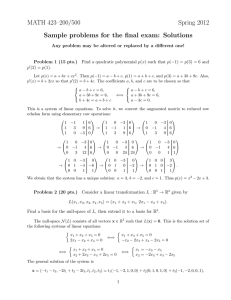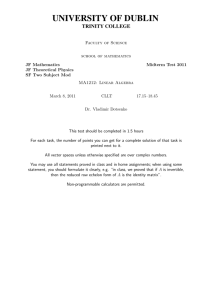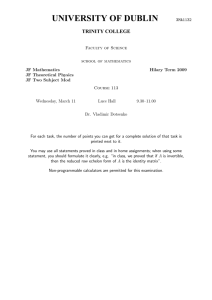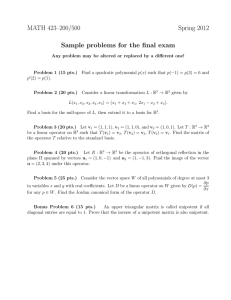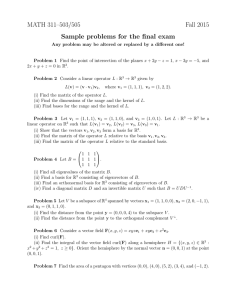MATH 423 Linear Algebra II Lecture 39: Review for the final exam.
advertisement
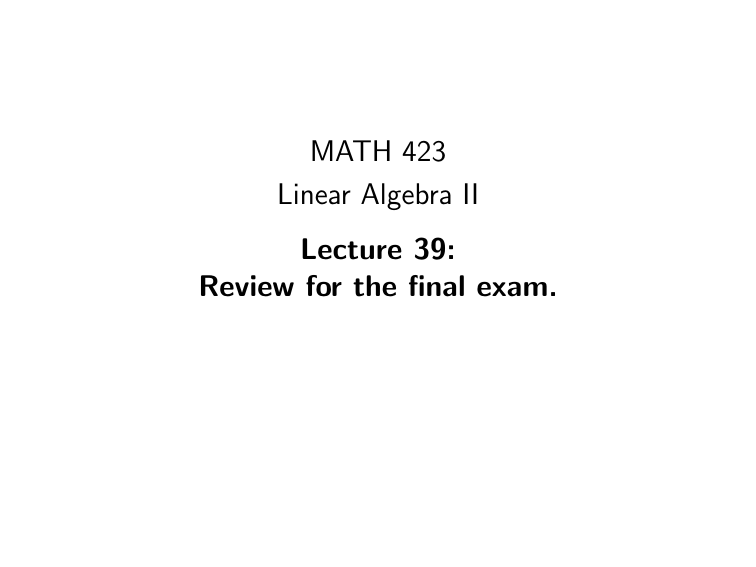
MATH 423 Linear Algebra II Lecture 39: Review for the final exam. Topics for the final exam Vector spaces (F/I/S 1.1–1.7, 2.2, 2.4) • Vector spaces: axioms and basic properties • Basic examples of vector spaces (coordinate vectors, matrices, polynomials, functional spaces) • Subspaces • Span, spanning set • Linear independence • Basis and dimension • Various characterizations of a basis • Basis and coordinates • Change of coordinates, transition matrix Topics for the final exam Linear transformations (F/I/S 2.1–2.5) • • • • • • • • • Linear transformations: definition and basic properties Linear transformations: basic examples Vector space of linear transformations Range and null-space of a linear map Matrix of a linear transformation Matrix algebra and composition of linear maps Characterization of linear maps from Fn to Fm Change of coordinates for a linear operator Isomorphism of vector spaces Topics for the final exam Elementary row operations (F/I/S 3.1–3.4) • Elementary row operations • Reduced row echelon form • Solving systems of linear equations • Computing the inverse matrix Determinants (F/I/S 4.1–4.5) • Definition for 2×2 and 3×3 matrices • Properties of determinants • Row and column expansions • Evaluation of determinants Topics for the final exam Eigenvalues and eigenvectors (F/I/S 5.1–5.4) • Eigenvalues, eigenvectors, eigenspaces • Characteristic polynomial • Diagonalization, basis of eigenvectors • Matrix polynomials • Cayley-Hamilton Theorem Jordan canonical form (F/I/S 7.1–7.2) • Jordan blocks • Jordan canonical form • Generalized eigenvectors • Jordan canonical basis Topics for the final exam Orthogonality (F/I/S 6.1–6.6, 6.11) • Norms and inner products • Orthogonal sets • Orthogonal complement • Orthogonal projection • The Gram-Schmidt orthogonalization process • Adjoint operator • Normal operators, normal matrices • Diagonalization of normal operators • Special classes of normal operators • Classification of orthogonal matrices • Rigid motions, rotations in space Sample problems for the final Problem 1 (15 pts.) Find a quadratic polynomial p(x) such that p(−1) = p(3) = 6 and p ′ (2) = p(1). Problem 2 (20 pts.) Consider a linear transformation L : R5 → R2 given by L(x1, x2, x3, x4, x5) = (x1 + x3 + x5, 2x1 − x2 + x4). Find a basis for the null-space of L, then extend it to a basis for R5 . Sample problems for the final Problem 3 (20 pts.) Let v1 = (1, 1, 1), v2 = (1, 1, 0), and v3 = (1, 0, 1). Let T : R3 → R3 be a linear operator on R3 such that T (v1) = v2, T (v2) = v3 , T (v3) = v1. Find the matrix of the operator T relative to the standard basis. Problem 4 (20 pts.) Let R : R3 → R3 be the operator of orthogonal reflection in the plane Π spanned by vectors u1 = (1, 0, −1) and u2 = (1, −1, 3). Find the image of the vector u = (2, 3, 4) under this operator. Sample problems for the final Problem 5 (25 pts.) Consider the vector space W of all polynomials of degree at most 3 in variables x and y with real coefficients. Let D be a ∂p for any linear operator on W given by D(p) = ∂x p ∈ W . Find the Jordan canonical form of the operator D. Bonus Problem 6 (15 pts.) An upper triangular matrix is called unipotent if all diagonal entries are equal to 1. Prove that the inverse of a unipotent matrix is also unipotent. Problem 1. Find a quadratic polynomial p(x) such that p(−1) = p(3) = 6 and p ′ (2) = p(1). Let p(x) = a + bx + cx 2 . Then p(−1) = a − b + c, p(1) = a + b + c, and p(3) = a + 3b + 9c. Also, p ′ (x) = b + 2cx so that p ′ (2) = b + 4c. The coefficients a, b, and c are to be chosen so that a − b + c = 6, a − b + c = 6, a + 3b + 9c = 6, a + 3b + 9c = 6, ⇐⇒ b + 4c = a + b + c a − 3c = 0. This is a system of linear equations in variables a, b, c. To solve it, we convert the augmented matrix to reduced row echelon form. 1 −1 1 6 3 9 6 . Augmented matrix: 1 1 0 −3 0 1 −1 1 6 1 0 −3 0 1 0 −3 0 1 3 9 6 → 1 −1 1 6 → 0 −1 4 6 1 0 −3 0 1 3 9 6 1 3 9 6 1 0 −3 0 1 0 −3 0 1 0 −3 0 4 6 → 0 −1 4 6 → 0 −1 4 6 → 0 −1 0 3 12 6 0 0 24 24 0 0 1 1 0 0 3 1 0 −3 1 0 −3 1 0 0 0 −2 → 0 1 0 −2 . → 0 1 −4 −6 → 0 1 1 1 1 0 0 1 0 0 1 0 0 1 Solution of the system: a = 3, b = −2, c = 1. Desired polynomial: p(x) = x 2 − 2x + 3. Problem 2. Consider a linear transformation L : R5 → R2 given by L(x1 , x2 , x3 , x4, x5 ) = (x1 + x3 + x5 , 2x1 − x2 + x4 ). Find a basis for the null-space of L, then extend it to a basis for R5 . The null-space N (L) consists of all vectors x ∈ R5 such that L(x) = 0. This is the solution set of the following systems of linear equations: x1 + x3 + x5 = 0 x1 + x3 + x5 = 0 ⇐⇒ −x2 − 2x3 + x4 − 2x5 = 0 2x1 − x2 + x4 = 0 x1 = −x3 − x5 x1 + x3 + x5 = 0 ⇐⇒ ⇐⇒ x2 = −2x3 + x4 − 2x5 x2 + 2x3 − x4 + 2x5 = 0 General solution: x = (−t1 − t3 , −2t1 + t2 − 2t3 , t1 , t2 , t3 ) = t1 (−1, −2, 1, 0, 0) + t2 (0, 1, 0, 1, 0) + t3 (−1, −2, 0, 0, 1), where t1 , t2 , t3 ∈ R. We obtain that the null-space N (L) is spanned by vectors v1 = (−1, −2, 1, 0, 0), v2 = (0, 1, 0, 1, 0), and v3 = (−1, −2, 0, 0, 1). These vectors are linearly independent (check out the last three coordinates), hence they form a basis for N (L). To extend the basis for N (L) to a basis for R5 , we need two more vectors. We can use some two vectors from the standard basis. For example, the vectors v1 , v2 , v3 , e1 , e2 form a basis for R5 . To verify this, we show that a 5×5 matrix with these vectors as columns has a nonzero determinant: −1 0 −1 1 0 1 0 −1 0 −1 −2 1 −2 0 1 0 1 −2 1 −2 = 1. =0 0 1 0 1 0 0 0 0 0 0 1 0 1 0 0 0 0 0 0 0 0 0 0 1 1 0 0 0 0 Problem 3. Let v1 = (1, 1, 1), v2 = (1, 1, 0), and v3 = (1, 0, 1). Let T : R3 → R3 be a linear operator on R3 such that T (v1 ) = v2 , T (v2 ) = v3 , T (v3 ) = v1 . Find the matrix of the operator T relative to the standard basis. Let U be a 3×3 matrix such that v1 , v2 , v3 : 1 1 U = 1 1 1 0 To determine whether v1 , v2 , v3 determinant of U: 1 1 1 0 det U = 1 1 0 = 1 1 0 1 1 its columns are vectors 1 0 . 1 is a basis for R3 , we find the 0 1 1 1 1 0 = = −1. 1 0 0 1 Since det U 6= 0, the vectors v1 , v2 , v3 are linearly independent. Therefore they form a basis for R3 . It follows that the operator T is defined well and uniquely. The matrix of the operator T relative to the basis v1 , v2 , v3 is 0 0 1 B = 1 0 0 . 0 1 0 Since U is the transition matrix from v1 , v2 , v3 to the standard basis, the matrix of T relative to the standard basis is A = UBU −1 . To find the inverse U −1 , we merge the matrix U with the identity matrix I into one 3×6 matrix and apply row reduction to convert the left half U of this matrix into I . Simultaneously, the right half I will be converted into U −1 . 1 1 1 1 0 0 1 0 0 1 1 1 (U|I ) = 1 1 0 0 1 0 → 0 0 −1 −1 1 0 1 0 1 0 0 1 1 0 1 0 0 1 1 1 1 0 −1 → 0 0 −1 0 1 1 0 0 → 0 −1 0 0 −1 1 → 0 0 1 0 0 1 1 1 1 0 −1 −1 1 0 → 0 −1 0 0 −1 −1 −1 0 1 1 0 0 −1 0 1 0 −1 0 1 → 0 −1 0 −1 0 0 −1 −1 −1 1 0 1 1 0 0 −1 1 0 1 0 −1 = (I |U −1 ). 0 1 1 −1 0 1 1 −1 A = UBU = 1 1 1 0 1 1 1 −1 = 1 0 1 1 0 1 1 1 0 0 0 1 1 0 1 1 0 1 1 0 0 0 1 −1 1 1 1 0 −1 0 1 0 0 1 0 1 0 1 −1 0 1 1 1 1 0 0 0 −1 = 0 0 1 . −1 0 2 −1 −1 Problem 4. Let R : R3 → R3 be the operator of orthogonal reflection in the plane Π spanned by vectors u1 = (1, 0, −1) and u2 = (1, −1, 3). Find the image of the vector u = (2, 3, 4) under this operator. By definition of the orthogonal reflection, R(x) = x for any vector x ∈ Π and R(y) = −y for any vector y orthogonal to the plane Π. The vector u is uniquely decomposed as u = p + o, where p ∈ Π and o ∈ Π⊥ . Then R(u) = R(p + o) = R(p) + R(o) = p − o. The component p is the orthogonal projection of the vector u onto the plane Π. We can compute it using the formula hu, v1i hu, v2i p= v1 + v2 , hv1 , v1 i hv2 , v2 i in which v1 , v2 is an arbitrary orthogonal basis for Π. To get an orthogonal basis for Π, we apply the Gram-Schmidt process to the basis u1 = (1, 0, −1), u2 = (1, −1, 3): v1 = u1 = (1, 0, −1), hu2 , v1 i v1 hv1 , v1 i −2 (1, 0, −1) = (2, −1, 2). = (1, −1, 3) − 2 v 2 = u2 − Now hu, v1i hu, v2i v1 + v2 hv1 , v1 i hv2 , v2 i −2 9 = (1, 0, −1) + (2, −1, 2) = (1, −1, 3). 2 9 p= Then o = u − p = (1, 4, 1). Finally, R(u) = p − o = (0, −5, 2). Problem 5. Consider the vector space W of all polynomials of degree at most 3 in variables x and y with real coefficients. ∂p for any Let D be a linear operator on W given by D(p) = ∂x p ∈ W . Find the Jordan canonical form of the operator D. The vector space W is 10-dimensional. It has a basis of monomials: 1, x, y , x 2, xy , y 2, x 3 , x 2 y , xy 2, y 3. Note that D(x m y k ) = mx m−1 y k if m > 0 and D(x m y k ) = 0 otherwise. It follows that the operator D 4 maps each monomial to zero, which implies that this operator is identically zero. As a consequence, 0 is the only eigenvalue of the operator D. To determine the Jordan canonical form of D, we need to determine the null-spaces of its iterations. Indeed, dim N (D) is the total number of Jordan blocks in the Jordan canonical form of D. Further, dim N (D 2 ) − dim N (D) is the number of Jordan blocks of dimensions at least 2×2, dim N (D 3) − dim N (D 2) is the number of Jordan blocks of dimensions at least 3×3, and so on. . . The null-space N (D) is 4-dimensional, it is spanned by 1, y , y 2, y 3. The null-space N (D 2) is 7-dimensional, it is spanned by 1, y , y 2, y 3 , x, xy , xy 2. The null-space N (D 3) is 9-dimensional, it is spanned by 1, y , y 2, y 3 , x, xy , xy 2, x 2 , x 2 y . The null-space N (D 4) is 10-dimensional. Therefore the Jordan canonical form of D contains one Jordan block of dimensions 1×1, 2×2, 3×3, 4×4. Jordan canonical form of 0 0 0 0 0 1 0 0 0 0 0 0 0 0 0 0 0 0 0 0 0 0 0 0 0 0 0 0 0 0 the operator D: 0 0 0 0 0 0 0 0 0 0 0 0 0 1 0 0 0 0 0 0 0 0 0 0 1 0 0 0 0 0 0 0 0 0 0 0 0 0 0 0 0 0 0 0 0 0 1 0 0 0 0 0 0 0 0 0 0 1 0 0 0 0 0 0 0 . 0 0 0 1 0 Bonus Problem 6. An upper triangular matrix is called unipotent if all diagonal entries are equal to 1. Prove that the inverse of a unipotent matrix is also unipotent. Let U denote the class of elementary row operations that add a scalar multiple of row #i to row #j, where i and j satisfy j < i . It is easy to see that such an operation transforms a unipotent matrix into another unipotent matrix. It remains to observe that any unipotent matrix A (which is in row echelon form) can be converted into the identity matrix I (which is its reduced row echelon form) by applying only operations from the class U. Now the same sequence of elementary row operations converts I into the inverse matrix A−1 . Since the identity matrix is unipotent, so is A−1 .

